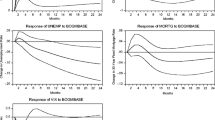Conclusion
This paper examines the hypothesis that the Great Contraction was the result of rational rent-seeking by members of the Federal Reserve System. In contrast to the AST hypothesis, evidence on the share prices of member banks that survived the contraction suggests that the owners of these banks suffered an absolute decline in real wealth and a decline relative to a broad spectrum of other investment alternatives. Furthermore, monetary surprises had no statistically discernible effect on the share prices of these banks. This evidence conflicts with the notion that rational rent-seeking would lead the owners of member banks and their bureaucratic conspirators in the Federal Reserve System to unleash a policy with the goal of contracting the money supply by 35 percent.
Similar content being viewed by others
References
Anderson, G.M., Shughart, W.F. and Tollison, R.D. (1988). A public choice theory of the Great Contraction. Public Choice 59: 3–23.
Bierwag, G.O., Kaufman, G. and Toevs, A. (1983). Duration: Its development and use in bond portfolio management. Financial Analysts Journal 39: 15–35.
Friedman, M. and Schwartz, A.J. (1963). A monetary history of the United States, 1867–1960. Princeton, NJ: Princeton University Press.
Maisel, S. and Jacobson, R. (1978). Interest rate changes and commercial bank revenues and costs. Journal of Financial and Quantitative Analysis 13: 687–700.
Samuelson, P.A. (1945). The effect of interest rate increases on the banking system. American Economic Review 35: 16–27.
Santoni, G.J. (1984). Interest rate risk and the stock prices of financial institutions. Federal Reserve Bank of St. Louis Review 66: 12–20.
Shughart, W.F. and Tollison, R.D. (1983). Preliminary evidence on the use of inputs in the Federal Reserve System. American Economic Review 73: 291–304.
Toma, M. (1982). Inflationary bias of the Federal Reserve System. Journal of Monetary Economics 10: 163–190.
Toma, E.F. and Toma, M. (1983). Research activities and budget allocations among Federal Reserve Banks. Public Choice 45: 175–191.
Author information
Authors and Affiliations
Rights and permissions
About this article
Cite this article
Santoni, G.J., Van Cott, T.N. The ruthless Fed: A critique of the AST hypothesis. Public Choice 67, 269–275 (1990). https://doi.org/10.1007/BF00224686
Received:
Accepted:
Issue Date:
DOI: https://doi.org/10.1007/BF00224686




